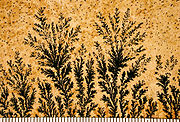
Pseudofossil
Encyclopedia

Fossil
Fossils are the preserved remains or traces of animals , plants, and other organisms from the remote past...
s. Pseudofossils may be misleading, as some types of mineral deposits can mimic lifeforms by forming what appear to be highly detailed or organized structures. One common example is when manganese
Manganese
Manganese is a chemical element, designated by the symbol Mn. It has the atomic number 25. It is found as a free element in nature , and in many minerals...
oxides crystallize
Crystallization
Crystallization is the process of formation of solid crystals precipitating from a solution, melt or more rarely deposited directly from a gas. Crystallization is also a chemical solid–liquid separation technique, in which mass transfer of a solute from the liquid solution to a pure solid...
with a characteristic treelike or dendritic
Dendrite (crystal)
A crystal dendrite is a crystal that develops with a typical multi-branching tree-like form. Dendritic crystal growth is very common and illustrated by snowflake formation and frost patterns on a window. Dendritic crystallization forms a natural fractal pattern...
pattern along a rock fracture. The formation of frost
Frost
Frost is the solid deposition of water vapor from saturated air. It is formed when solid surfaces are cooled to below the dew point of the adjacent air as well as below the freezing point of water. Frost crystals' size differ depending on time and water vapour available. Frost is also usually...
dendrites on a window is another common example of this crystal growth. Concretion
Concretion
A concretion is a volume of sedimentary rock in which a mineral cement fills the porosity . Concretions are often ovoid or spherical in shape, although irregular shapes also occur. The word 'concretion' is derived from the Latin con meaning 'together' and crescere meaning 'to grow'...
s are sometimes thought to be fossils, and occasionally one contains a fossil, but are generally not fossils themselves. Chert
Chert
Chert is a fine-grained silica-rich microcrystalline, cryptocrystalline or microfibrous sedimentary rock that may contain small fossils. It varies greatly in color , but most often manifests as gray, brown, grayish brown and light green to rusty red; its color is an expression of trace elements...
or flint
Flint
Flint is a hard, sedimentary cryptocrystalline form of the mineral quartz, categorized as a variety of chert. It occurs chiefly as nodules and masses in sedimentary rocks, such as chalks and limestones. Inside the nodule, flint is usually dark grey, black, green, white, or brown in colour, and...
nodules in limestone
Limestone
Limestone is a sedimentary rock composed largely of the minerals calcite and aragonite, which are different crystal forms of calcium carbonate . Many limestones are composed from skeletal fragments of marine organisms such as coral or foraminifera....
can often take forms that resemble fossils.
Pyrite
Pyrite
The mineral pyrite, or iron pyrite, is an iron sulfide with the formula FeS2. This mineral's metallic luster and pale-to-normal, brass-yellow hue have earned it the nickname fool's gold because of its resemblance to gold...
disks or spindles are sometimes mistaken for fossils of sand dollar
Sand dollar
The term Sand dollar refers to species of extremely flattened, burrowing echinoids belonging to the order Clypeasteroida. Some species within the order, not quite as flat, are known as sea biscuits...
s or other forms (see marcasite
Marcasite
The mineral marcasite, sometimes called white iron pyrite, is iron sulfide with orthorhombic crystal structure. It is physically and crystallographically distinct from pyrite, which is iron sulfide with cubic crystal structure. Both structures do have in common that they contain the disulfide...
). Cracks, bumps, gas
Gas
Gas is one of the three classical states of matter . Near absolute zero, a substance exists as a solid. As heat is added to this substance it melts into a liquid at its melting point , boils into a gas at its boiling point, and if heated high enough would enter a plasma state in which the electrons...
bubbles, and such can be difficult to distinguish from true fossils. Specimens which cannot be attributed with certainty to either the fossils or the pseudofossils are treated as dubiofossil
Dubiofossil
The term dubiofossil is a portmanteau word used in geology and paleontology for a problematic structure that looks like a fossil, but whose biologic origin is uncertain....
s. Debates about whether specific forms are pseudo or true fossils can be lengthy and difficult. For example, Eozoön
Eozoon
Eozoön canadense is a pseudofossil.John William Dawson described the banded structures of coarsely crystalline calcite and serpentine as a gigantic Foraminifera, making it the oldest known fossil. It was found in Precambrian metamorphosed limestone of Canada, at Côte St. Pierre near Grenville in...
is a complex laminated form of interlayered calcite
Calcite
Calcite is a carbonate mineral and the most stable polymorph of calcium carbonate . The other polymorphs are the minerals aragonite and vaterite. Aragonite will change to calcite at 380-470°C, and vaterite is even less stable.-Properties:...
and serpentine originally found in Precambrian
Precambrian
The Precambrian is the name which describes the large span of time in Earth's history before the current Phanerozoic Eon, and is a Supereon divided into several eons of the geologic time scale...
metamorphosed limestone
Limestone
Limestone is a sedimentary rock composed largely of the minerals calcite and aragonite, which are different crystal forms of calcium carbonate . Many limestones are composed from skeletal fragments of marine organisms such as coral or foraminifera....
s (marbles). It was at first thought to be the remains of a giant fossil protozoan (Dawson, 1865), then being by far the oldest fossil known. Similar structures were subsequently found in metamorphosed limestone blocks ejected during an eruption of Mt. Vesuvius. It was clear that high-temperature physical and chemical processes were responsible for the formation of Eozoön in the carbonate rock (O'Brien, 1970). The debate over the interpretation of Eozoon was a significant episode in the history of paleontology (Adelman, 2007).

